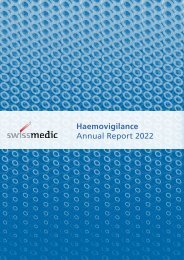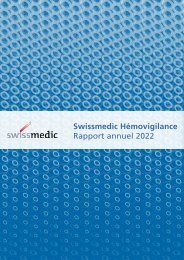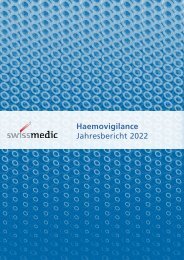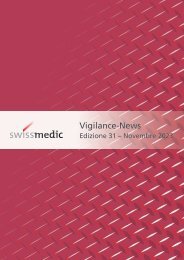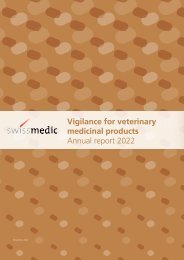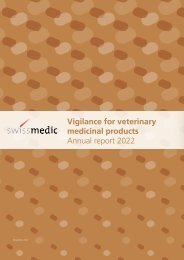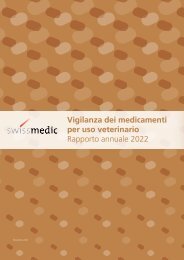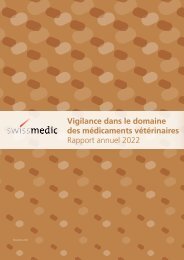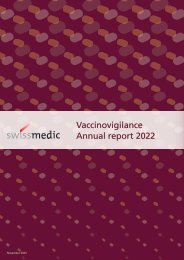Swissmedic Annual Report 2018
2018 Annual Report and annual financial statements of the Swiss Agency for Therapeutic Products (Swissmedic)
2018 Annual Report and annual financial statements of the Swiss Agency for Therapeutic Products (Swissmedic)
- No tags were found...
Create successful ePaper yourself
Turn your PDF publications into a flip-book with our unique Google optimized e-Paper software.
9<br />
The situation subsequently calmed down. Over recent<br />
months, <strong>Swissmedic</strong> has continued to test for NDMA and<br />
NDEA, and has now analysed all finished drug products<br />
available in Switzerland that contain valsartan, losartan,<br />
irbesartan, olmesartan and candesartan for the impurities.<br />
All the products that are available in Switzerland can be<br />
considered safe.<br />
<strong>Swissmedic</strong> lab plays pioneering role<br />
Detecting very low concentrations of nitrosamines by analytical<br />
chemistry is a challenging task. Since there were no<br />
sufficiently sensitive, validated methods capable of testing<br />
for tiny quantities of NDMA and NDEA at the same time,<br />
<strong>Swissmedic</strong>’s lab first had to develop and validate appropriate<br />
tests. At the time, no laboratory outside Switzerland<br />
was able to detect such small concentrations of NDEA impurities<br />
using existing test methods. The pioneering role<br />
that the <strong>Swissmedic</strong> laboratory played in the field earned it<br />
international acclaim.<br />
Directorate of the Council of Europe that plays a key role in<br />
monitoring active pharmaceutical substance quality.<br />
Although <strong>Swissmedic</strong>’s investigations and actions have defused<br />
the situation, the problem has not yet been fully resolved.<br />
New findings are still emerging. The fact that the<br />
flood of reports of impurities is subsiding only slowly indicates<br />
that <strong>Swissmedic</strong> will have to continue testing sartans<br />
for some considerable time to come. <strong>Swissmedic</strong> will also<br />
have to hold discussions with its international partner authorities<br />
on how to prevent a repetition of such cases, for<br />
example by addressing the way active substance manufacturers<br />
are supervised.<br />
To facilitate and speed up the roll-out of sensitive tests to<br />
manufacturers, <strong>Swissmedic</strong> decided to publish its analytical<br />
method. The method was also made available to the European<br />
Directorate for the Quality of Medicines (EDQM), a<br />
Sartans<br />
i<br />
The sartan group of medicinal products include preparations containing the active substances valsartan, losartan,<br />
olmesartan, candesartan and irbesartan, as well as a number of other active substances. These medicinal products are<br />
also known as angiotensin II receptor antagonists.<br />
Sartans have antihypertensive and vasodilatory effects, and are used for the treatment of high blood pressure, heart<br />
failure or kidney disorders. Most sartans are available as tablets or film-coated tablets, alone or in combination with other<br />
active substances.<br />
According to the WHO’s International Agency for Research on Cancer, animal testing has shown that nitrosamines such as<br />
NDMA, NDEA, NDELA and NMOR can cause cancer. The Agency therefore suspects that they will do the same in<br />
humans, even though there have been no epidemiological studies of the subject. Exposure to nitrosamines should be<br />
minimised as a precautionary measure, not least because they are present in many other sources, including foodstuffs,<br />
alcoholic beverages, tobacco products, certain cosmetics and rubber products.




